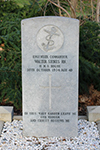Commonwealth War Grave General Cemetery Kleverlaan
At the Kleverlaan General Cemetery in Haarlem, there is a Commonwealth war grave from the First World War. It is the grave of a British sailor, Walter STOKES, Engineer Commander, H.M.S. ‘Hogue’, Royal Navy.
The date of death on the gravestone is 20 October 1914, according to the CWGC register 22 September 1914. On 22 September 1914, H.M.S. Hogue was torpedoed.
Epitaph: ‘IN THIS VAST GARDEN LEAVE ME GOD REDEEM AND CHRIST RECEIVE ME’.
Background
In 1914, Walter Stokes was the chief engineer (engineer commander) of H.M.S. Hogue, an old English cruiser, whose captain was Wilmot Stuart Nicholson.
At the start of the First World War, on 22 September 2014, a naval battle took place in the North Sea.
In the early morning, three old British cruisers were patrolling the North Sea to protect the supply route to France: the Hogue, the Aboukir and the Cressy. A German U9 submarine fired torpedoes at these three cruisers, causing the ships to sink beneath the waves.
More than 2,000 British sailors were left in the water or floating in one of the few rafts or lifeboats. There were almost no life jackets on board the ships. 837 crew members were rescued by Dutch fishing boats and merchant ships or managed to reach the Dutch coast on rafts. 1,459 crew members drowned.
The ships Aboukir, Hogue and Cressy still form the largest mass grave in the North Sea.
A number of the shipwrecked were transported by the ship “Flora” to IJmuiden, where they were taken in by hotels. Among the shipwrecked were one seriously injured person, Walter Stokes, and four slightly injured.
The owner of the Duin en Kruidberg estate, J.T. Cremer, addressed the shipwrecked in IJmuiden and took the captain of the Hogue, Nicholson, and 38 others by car to his estate to spend the night.
The steward of Duin en Kruidberg, jonkheer Mock, ensured that these shipwrecked sailors could send postcards to their families. They wrote home that they had been treated like “lords”.
Walter Stokes did not go to Duin en Kruidberg. He had suffered severe bruising and was admitted to the Elisabeth Gasthuis hospital in Haarlem.
He died there on 21 October 1914 at the age of 40 from his injuries.
Stokes was given a military funeral in Haarlem on 23 October 1914, after which he was buried on Kleverlaan, in a Commonwealth war grave from the First World War.
Do you have more information about this location? Inform us!
Source
- Text: TracesOfWar & Hans Prins
- Photos: Luc Van Waeyenberge
- Villa Valkenhoef Santpoort – De geschiedenis van Villa Valkenhoef’, Frans Looij
- LEEUWEN, M. VAN & STAARMAN, A., Tastbare Herinneringen 1914-1918, Western Front Association Nederland, 2008.
Nearby
Museum
Point of interest
- Stelling van Amsterdam - Ripperda Barrack Haarlem - Haarlem
- Former House of Hannie Schaft, Haarlem - Haarlem
- Stelling van Amsterdam - Protestant Military Hostel - Haarlem
Monument
- Memorial Plaques Haarlem Train Station - Haarlem
- Memorial Liberation 5 May 1945 Haarlem - Haarlem
- Memorial 'Woman in the Resistance' - Haarlem
Cemetery
- Dutch War Graves General Cemetery Kleverlaan - Haarlem
- Dutch War Graves Roman Catholic Cemetery St. Barbara - Haarlem
- Dutch War Grave Roman Catholic Cemetery St. Bavo - Haarlem
Remembrance Stone
- Stumbling Stones Generaal Cronjéstraat 127 - Haarlem
- Stumbling Stones Generaal Cronjéstraat 67 - Haarlem
- Stumbling Stones Lindenstraat 22 - Haarlem
Fortification
- FLAK Stand Haarlem - Haarlem
- Stelling van Amsterdam - Inlet culvert Waarderpolder - Haarlem
- Stelling van Amsterdam - Dam Lock Heksloot - Spaarndam




